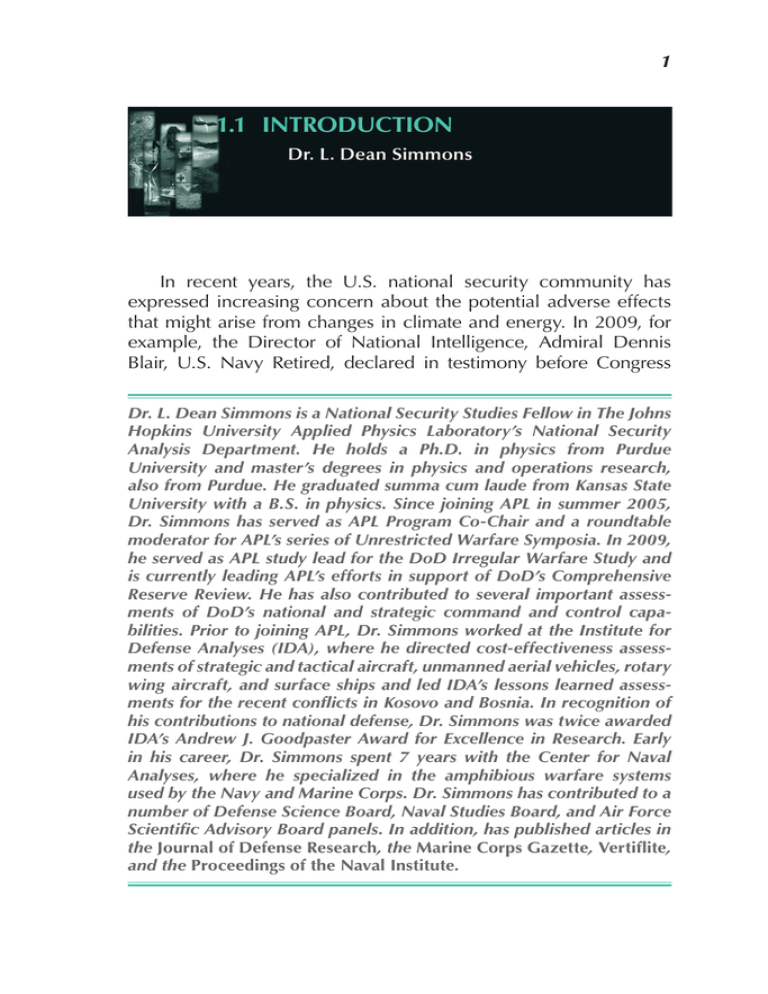1.1 INtRoDuCtIoN
advertisement

1 1.1 Introduction Dr. L. Dean Simmons In recent years, the U.S. national security community has expressed increasing concern about the potential adverse effects that might arise from changes in climate and energy. In 2009, for example, the Director of National Intelligence, Admiral Dennis Blair, U.S. Navy Retired, declared in testimony before Congress Dr. L. Dean Simmons is a National Security Studies Fellow in The Johns Hopkins University Applied Physics Laboratory’s National Security Analysis Department. He holds a Ph.D. in physics from Purdue University and master’s degrees in physics and operations research, also from Purdue. He graduated summa cum laude from Kansas State University with a B.S. in physics. Since joining APL in summer 2005, Dr. Simmons has served as APL Program Co-Chair and a roundtable moderator for APL’s series of Unrestricted Warfare Symposia. In 2009, he served as APL study lead for the DoD Irregular Warfare Study and is currently leading APL’s efforts in support of DoD’s Comprehensive Reserve Review. He has also contributed to several important assessments of DoD’s national and strategic command and control capabilities. Prior to joining APL, Dr. Simmons worked at the Institute for Defense Analyses (IDA), where he directed cost-effectiveness assessments of strategic and tactical aircraft, unmanned aerial vehicles, rotary wing aircraft, and surface ships and led IDA’s lessons learned assessments for the recent conflicts in Kosovo and Bosnia. In recognition of his contributions to national defense, Dr. Simmons was twice awarded IDA’s Andrew J. Goodpaster Award for Excellence in Research. Early in his career, Dr. Simmons spent 7 years with the Center for Naval Analyses, where he specialized in the amphibious warfare systems used by the Navy and Marine Corps. Dr. Simmons has contributed to a number of Defense Science Board, Naval Studies Board, and Air Force Scientific Advisory Board panels. In addition, has published articles in the Journal of Defense Research, the Marine Corps Gazette, Vertiflite, and the Proceedings of the Naval Institute. 2 Climate and Energy Proceedings 2010 that “climate change, energy, and other factors are often intertwined, and while not traditionally viewed as ‘threats’ to U.S. national security . . . will affect Americans in major ways.” [1] Last September the Central Intelligence Agency established a Center for Climate Change and National Security to assess the impacts of such climate effects as “desertification, rising sea levels, population shifts, and heightened competition for national resources.” [2] And this year, the Department of Defense’s (DoD’s) new Quadrennial Defense Review, the QDR 2010, devotes an entire section, some six or seven pages, to the task of “crafting a strategic approach to climate and energy.” [3] Let’s look at what the QDR 2010 had to say in a little more detail. The report notes that “climate change and energy are two key issues that will play a significant role in shaping the future security environment.” Two types of climate-related effects are noted. “First, climate change will shape the operating environment, roles, and missions that we [DoD forces] undertake. . . . Second, DoD will need to adjust to the impact of climate change on our facilities and military capabilities.” The QDR 2010 then goes on to identify some of the specific climate effects of concern to DoD, citing as its source the integrated perspective pulled together by the U.S. Global Change Research Program. This program integrates the climate-related activities of seven federal departments—Commerce, DoD, Energy, Interior, State, Health and Human Services, and Agriculture—as well as the National Oceanic and Atmospheric Administration (NOAA), the National Aeronautics and Space Administration (NASA), the National Science Foundation, the U.S. Environmental Protection Agency (EPA), the U.S. Agency for International Development (USAID), and the Smithsonian Institution. The effects of concern include rising atmospheric and ocean temperatures, rising sea level, retreating glaciers, thawing permafrost, lengthening growing seasons, lengthening ice-free seasons in the oceans (especially in the Arctic) as well as on lakes and rivers, increases in heavy downpours, earlier snowmelt, and alterations in river flows. According to the QDR 2010, such effects can increase the likelihood of poverty, lead to environmental degradation, and further weaken already fragile governments. Climate change also Chapter 1 Introduction and Keynote Address 3 can contribute to food and water scarcity, increase the spread of disease, and spur or exacerbate mass migration. Turning next to changes in energy, the QDR 2010 declares that energy security for DoD means “having assured access to reliable supplies of energy” and being able “to protect and deliver sufficient energy to meet operational needs.” To put the first concern in perspective, let’s look at some data from a recent report by DoD’s Energy Information Administration (EIA). In Figure 1, the upper pie chart shows average daily petroleum use measured in thousands of barrels (Kbbl) for the top 15 oil-consuming nations. As is clear from the chart, the United States is far and away the largest consumer. China is second, India is sixth. The lower pie chart shows the same data adjusted for population. When we look at the data this way, America still ranks near the top, trailing only Saudi Arabia and Canada. On a per-capita basis, the average Chinese citizen consumes 1/13th as much oil as the average American; the average Indian citizen, only 1/30th as much. This drop is, of course, due to these countries’ billion-plus populations. At the same time, these massive populations mean that a modest increase in per-capita consumption will turn into a substantial increase in national consumption. A 1% increase in percapita consumption for either China or India will mean a 4% or 5% increase in national consumption relative to the United States. A 2% increase will mean an 8–10% increase. Having looked at consumption, let us take a quick look at production. Figure 2 shows EIA data for the 23 largest petroleum producers, measured again in thousands of barrels per day. The roughly 8500 barrels per day produced in the United States provide approximately 40% of the 20,700 barrels we consume each day. The other 60% must be imported, sometimes from nations whose interests differ markedly from our own. Although few of us may be trained as economists, most of us know that the combination of supply and demand determines price. When the demand is high and the supply is low, the price goes up. Although there is some disagreement as to whether the world is nearing peak production for oil, there is no disagreement that 4 Climate and Energy Proceedings 2010 Figure 1. Average Daily Petroleum Use for Top 15 Oil-Consuming Nations Chapter 1 Introduction and Keynote Address 5 Figure 2. Petroleum Production for the 23 Largest Petroleum-Producing Nations changes of only a few percent in the demand or supply for petroleum can lead to substantial changes in price. Just 2 years ago, the price per barrel peaked at nearly $150; then when demand dropped during the recession that began in 2008, the price dropped rapidly (see the far right-hand side of Figure 3). Now that economies are improving, price is climbing rapidly. It is already over $80 a barrel, and, as any of you know who have purchased gas recently, it is climbing weekly. So that is what is happening globally in terms of climate and energy. Our concern today is what those changes mean for our nation’s naval forces. Let’s look first at climate. We have all heard about changes in Arctic sea ice and the potential for new shipping 6 Climate and Energy Proceedings 2010 Figure 3. Crude Oil Prices in 2008 Dollars routes and access to natural resources. Several of the presentations that follow will address this important topic. Our naval forces, of course, operate at sea, and sea level is rising. That rise will be particularly relevant to the 40% of the globe’s 7 billion people who live within 60 miles of the coast. Sea-level rise will also affect the many seaside installations and bases used by the Navy, the Marines, and the Coast Guard. Changes in the frequency and severity of storms will affect demand for humanitarian assistance, such as that provided by our naval forces. In recognition of just such considerations, the Navy established Task Force Climate Change. A presentation by the director of that task force is included in Chapter 2 of this volume. On the energy side, our Naval forces devote significant resources to the task of securing U.S. access to energy resources, especially petroleum, and those forces use large amounts of increasingly expensive petroleum products themselves. In recognition of considerations such as these, the Navy established Task Force Energy, and the Marines set up the Expeditionary Energy Chapter 1 Introduction and Keynote Address 7 Office. Presentations from the directors of both of those organizations appear in subsequent chapters of this proceedings. So that brings us to our overall objective, to examine how changes in climate and energy might affect future U.S. naval forces. In particular, we want to look at what our naval forces need to be able to do, how they should be organized to accomplish those tasks, and how they should be equipped. We look at all three naval services: the Navy, the Marines, and the Coast Guard (Figure 4). And because the effects will differ from one geographic region to another, we will look at the problem from that perspective as well. In the chapters that follow, we will look first at climate and energy and then examine the implications for naval operations in North and South America, Europe and Africa, and Asia and the Pacific. Our speakers and panelists include representatives from each of the relevant combatant commands (see Figure 5). The final chapter of this proceedings reports on the observations of the Integration and Synthesis Panel, whose objective was to draw out the key findings from the entire collection of presentations and panel discussions. Figure 4. Naval Service Emblems 8 Climate and Energy Proceedings 2010 Figure 5. Geographic Regions ReferenceS 1. Dennis C. Blair, Annual Threat Assessment of the Intelligence Community for the Senate Select Committee on Intelligence, 12 Feb 2009, http://www.dni.gov/testimonies/20090212_ testimony.pdf. 2. Central Intelligence Agency, CIA Opens Center on Climate Change and National Security, Press Release, 25 Sept 2009, https:// www.cia.gov/news-information/press-releases-statements/ center-on-climate-change-and-national-security.html. 3. Department of Defense, Quadrennial Defense Review Report, Feb 2010, http://www.defense.gov/qdr/.

